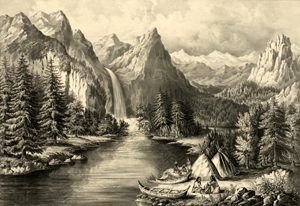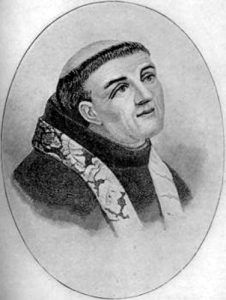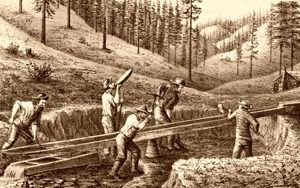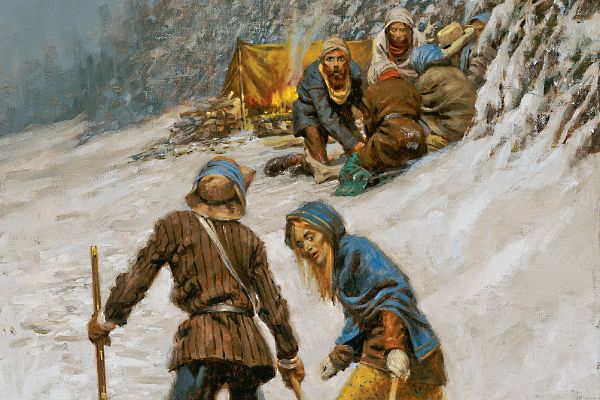By Patricia Molen van Ee, 2001
The picture that comes to mind for most people when women are discussed in the context of historical travels to California is that of the overland wagon trains moving westward, peopled by sturdy and daring pioneers who arrived in California after the discovery of gold in 1848. A few might also mention that some women came by ship, interrupting their voyage with an arduous trek — on foot or by mule — across the Isthmus of Panama, all the while with small children in tow. Even fewer people know that these women were relative latecomers to the Golden State, as California became known.
When Anglo-Americans began arriving in California in large numbers during the 19th century, they were part of the third wave of migration to the Pacific Coast. The first immigrants were Indians who had lived in California for ten to fifteen thousand years before Old World explorers visited the region. A prevalent myth that the rich land was empty, ripe for colonization, is refuted by recent studies indicating that “at the time of Euro-American contact, California was more densely populated than any area of equal size in North America, north of central Mexico. What was labeled “wilderness,” actually harbored human gathering and hunting sites, burial grounds, work sites, sacred areas, trails, and village sites.
Our understanding of the California Indians is limited by the absence of written cultural artifacts, except for a few drawings on cave or canyon walls. It is further hampered by a lack of understanding of the ecology of California’s landscape before European contact, which took place over several centuries.
What is clear, however, is that the Indians altered the physical environment through planting, pruning, irrigating, and periodically burning vegetation and that Indian women played major and very specific roles in these activities.
There is, however, an abundance of written source material about the second wave of immigrants who settled the borderlands in the northernmost portion of the Spanish empire. Incursions by the British and Russians and the fear that others might attempt to claim additional areas of the North American continent motivated Spain to create a solid military and human presence along the California coast. Between 1769 and 1821, 20 missions, four presidios, and three civil communities known as pueblos were built, stretching from San Diego to just north of San Francisco.
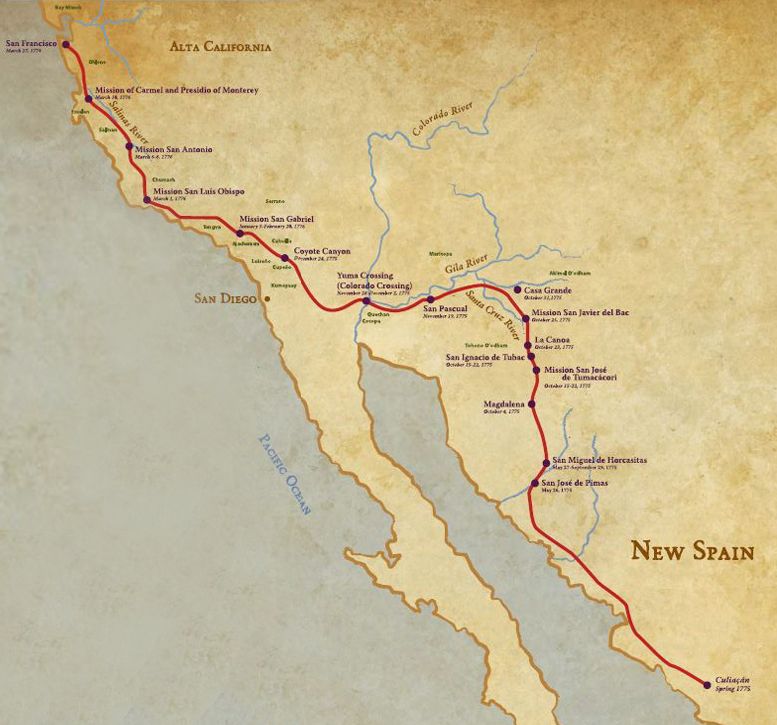
Juan Bautista de Anza Expedition
For the first time, Anza established an overland route across the desert, connecting established portions of New Spain with the California outposts, 600 miles of which required blazing a new trail. His first expedition in 1774 transported 40 soldiers, 12 women, and several children. By the time he returned to Monterrey, Mexico, to report his success to his superiors, he had covered over 2,000 miles.
The trail’s opening was maintained by preserving friendly relations with the Indians in its vicinity. A continuing need for settlers to protect Spanish interests in the region led to his most stunning success — shepherding 240 men, women, and children, including seven infants under eight months, across the desert and up the California coast.
The expedition left Tubac on October 23, 1775. Winter came unusually early that year; it was unseasonably cold, with record-breaking snow and ice. The colonists, used to the warm climate of Mexico, were unprepared for the hardships they faced. Rations were short, finding potable water was difficult, people and livestock sickened, and many animals weakened or died.
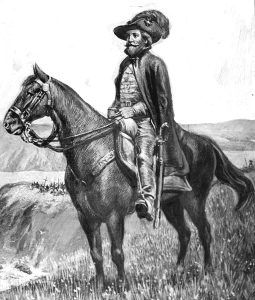
Captain Juan Bautista de Anza II
Despite the adverse conditions, Juan Bautista de Anza arrived at Monterey, California, with two more people than he had enlisted for the long journey to Alta, California, three of whom were born on the trail. He lost only one person on the trip, a mother of six, Señora Felix, who died in childbirth the first night. All of the rest of the party, including the newborns, survived. Such a successful outcome overland to California was never equaled — before, during, or after the Gold Rush — and had the 13 diaries penned on his two expeditions been written in English rather than Spanish, Anza would today be known throughout the world as a famous leader, and the names of some of the remarkable women who traveled with him would be remembered.
Although none of the women traveling north from Mexico left written journals of their thoughts, feelings, and experiences on the trail, fascinating vignettes can be extracted from the diaries kept by the men who accompanied them. For example, we know that because the primary purpose of the 1775 expedition was to populate Spanish California, Anza actively recruited young married couples and that three marriages took place along the way. The ideal of 18th and 19th-century womanhood influenced the recruitment of suitable colonists from among the poorer Mexican families. Spanish expectations for women were, by and large, those that crossed national and cultural lines: western women were to be pious, pure, domestic, and modest, whether English, French, or Spanish-Mexican. There were, however, some exceptions to the general patterns of behavior and family composition expected of all women regardless of their social class.
From the beginning, families were sent to these outposts to increase the population of Spanish citizens. In addition to the relatively few people who could be considered Hispanic, having been born in Spain or of solely Spanish ancestry, the vast majority of the colonists came from Mexico, where some of their families had lived for at least two generations. Included were many mestizos, part Native American and part Spanish or Mexican, and mulattoes and blacks. California, already populated by multiple Native American cultural groups, with the arrival of these newer immigrants, became a model of diversity that continues to the present day.
Among the best-documented expeditions in North American history are the two overland journeys led by Juan Bautista de Anza in 1774 and 1775. How colonists from the Spanish provinces of Sinaloa and Sonora in what is now Mexico migrated as families to the San Francisco Bay area — traveling from the Tubac garrison on Sonora’s northern frontier, traversing the Sonoran desert, the treacherous Gila and Colorado Rivers and rugged mountain ranges; and then moving up California’s Central Valley — is one of the most amazing and least known stories in American history.
The women who accompanied Anza were primarily from the lower classes of Mexican society. One of them, however, was not from that social grouping. Maria Feliciana Arballo was born into a wealthy family in Spain and was only 20 years old when she and her mestizo husband signed on to travel with Anza. The journey to California would have helped them escape the rigid class society in established parts of the Spanish empire that denigrated her husband based on color and race. His sudden death before the journey did not deter her from insisting that she and her two young daughters be permitted to accompany Anza to California. Perhaps the persuasiveness of her arguments convinced Anza, despite strong objections from Father Pedro Font, to make an exception to his policy that male family members accompany all women. She and her daughters, one riding in front of her, the other behind, traveled on horseback to California. Once there, she again asserted her independence by leaving the group in San Gabriel, where she entered a second marriage. The man she chose was also a mestizo soldier.
Arballo was a high-spirited young woman because Father Pedro Font was repeatedly annoyed with her and Anza, who had permitted her to go to California against the priest’s adamant opposition. Font confided in his diary that she drank alcohol excessively one evening when the group was celebrating, having completed an arduous portion of the journey. Font also noted her inappropriate behavior, commenting that the “very bold widow . . . sang some verses which were not at all nice, applauded and cheered by the crowd.” She refused to play the submissive and modest role required of women of her time, and by performing in public, she resisted the social controls usually governing Spanish women’s actions. She also defied, not once but twice, the class and color constraints of Hispanic culture by marrying ordinary soldiers who were mestizo when she was of Spanish birth. In marrying beneath her class and caste, defying her priest’s advice, resisting male authority, and acting boldly in the public sphere, she subverted the gender requirements of proper behavior for women of her time.
At the highest end of California’s social spectrum, although not a member of Anza’s party, was Eulalia Callis, born in Spain to an influential family. She became the wife of Alta California governor Pedro Fages. Despite her prominent position, she made private matters public in 1785 by openly accusing her husband of infidelity and refusing to sleep with him; she also insisted on returning to Mexico City. The governor denied wrongdoing, and their priest advised her to drop the matter when she consulted him about divorce. She refused to do so and was punished for her actions by imprisonment, isolation, the continual threat of flogging, and ex-communication from the Church. Although her contemporaries were unsympathetic, Callis’ actions, in retrospect, appear to have been motivated by a strong survival instinct, for she had endured four pregnancies in six years, buried two of her children, and longed, understandably, to return to a safer and more comfortable life in Mexico City.
Notably successful in exercising her independence was a third woman, Apolinaria Lorenzana, who arrived on the ship Concepcion with her widowed mother. In keeping with Spanish norms, which were clearly stated in the context of sending ten female foundlings to California in 1800, Señorita Lorenzana was supposed to marry and bear children to bolster the population of the northern borderlands of the Spanish empire. She never consented to doing either, despite a proposal from a young Californian. Her strategy for avoiding marriage, “because I was not particularly inclined toward that state even though I knew the merits of that sacred institution,” was to perform valued work by cooking, nursing, and caring for the Native Americans who lived near the mission. “La Beata” was respected, admired, and loved for her life of service, and thus maintained control of her sexuality and lived a life of independence, supporting herself by working for the Church. Her efforts resulted in her being one of the few women in California to receive a land grant in her name.
The great watershed in California’s history began with the American conquest of the Mexican province, followed almost immediately by the discovery of gold in 1848, widespread immigration in a rush to the goldfields, and California’s admission to the Union in 1850. Socially, economically, and demographically, California became unrecognizable almost overnight as San Francisco changed from a small town to a bustling port, and mining camps and villages sprang up all along the eastern slopes of the Sierras.
American and foreign immigrants added to the diversity and complexity already existing in California society. Several mulatto families had traveled to California with Anza, and intermarriage between races was so frequent that the racial classification system in colonial New Spain was highly formalized — including terms such as “castizo” and “morisco.” One scholar noted that “approximately 55 percent of the Spanish-speaking population in California in 1790 was of mixed heritage,” and 20 percent may have possessed some African ancestry.
Forty-niners were drawn to the goldfields from all around the globe. Of particular interest — because the Asian population of North America before the Gold Rush was extremely low — was the number of immigrants from China who sailed to Northern California within a narrow period, creating a unique community there. Relatively few Chinese women immigrated: in 1890, there were 69,382 Chinese men, in California and 3,090 women. San Francisco customhouse records for 1852 show that 20,026 Chinese arrived by sea that year; soon after that, the city’s Chinatown included Chinese girls imported for prostitution, many of whom had been sold by impoverished parents or stolen off the streets in China.
The vast majority of men and women on the move to California during the Gold Rush, however, came from east of the Mississippi River. Many of them had already relocated once in their lifetimes to the old northwest, leaving for California from small farms in Illinois, Indiana, and Ohio. Others, including Mrs. D. B. Bates, the wife of a sea captain who had three ships burn under her during her voyage around Cape Horn to San Francisco, departed from the eastern seaboard. Those whose journey overland consisted of crossing the Isthmus of Panama wrote about their novel experiences, including riding on mules, sometimes wearing men’s clothing, sleeping on the ground or in Indian huts, and their horror at being served baked monkey for dinner. For some, it was an adventure; for others an excruciating ordeal.
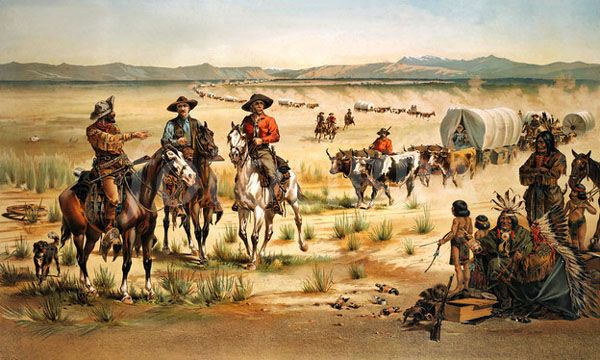
A wagon train and Indians
Although the story of the trip overland from the east is well known to most, recent scholarship has helped us to understand more about the social and psychological effects of being uprooted from their homes and how life on the trail affected women. In her comprehensive work Women’s Diaries of the Westward Journey, Lillian Schlissel has identified and analyzed almost 100 diaries and journals kept by women moving west in the decades between 1840 and 1870. Schlissel points out that male family members generally made the decision to move west and were only reluctantly accepted by women. The difference between men and their wives in their willingness to go to California was related to the life cycles of men and women: men were in the most active phases of their lives and were eager to break free and take whatever risk might make them wealthy. If their search for gold proved unsuccessful, they could obtain land and resume farming. Most of the women, however, were in their childbearing years and at a stage where they wanted to put down roots and enjoy a sense of community and the company of other women and their families; many went to California reluctantly.
The long journey to California exacerbated marriage tensions, and women exercised their options in California when seeking a divorce. There was a lengthy list of grounds upon which an action could be based, including “natural impotence, minority, adultery, extreme cruelty, habitual intemperance, desertion, willful neglect, consent obtained by force or fraud, and conviction for a felony.”
Despite obvious differences between the women who traveled with Anza and the Anglo-American women regarding divorce, there were many similarities in the two waves of migration. Women in both groups experienced birth, miscarriages, and death; few females traveled outside of their family unit; there were hardships, deprivation, and continual exposure to extremes in temperature and weather conditions; and the women were expected to cook, wash the clothing, nurse the sick, and carry and tend to their children.
The degree to which they suffered, however, was dramatically different. Those traveling westward in the mid-nineteenth century lacked the cohesion and leadership found in the Anza expedition. Attempted shortcuts and turnoffs on the trail resulted in disasters such as the one suffered by the Donner Party. In addition, cholera was rampant, and the way became lined with the graves of those who had died from measles, dysentery, smallpox, and fevers. Infant mortality played a significant role in the loss of life, and contaminated water and spoiled food contributed to the overall misery and deaths of others. One diarist, Cecelia McMillen Adams, morbidly recorded over two hundred grave sites along the trail from Illinois in 1852.
Superior planning included blazing the trail that was taken, maintaining good relations with the Indians, and properly equipping the participants. The Spanish specifically recruited persons deemed most suitable for the journey and life on the frontier, an advantage the Anglo-Americans on the westward trail did not enjoy. While the Anza expedition was a small and relatively cohesive group, the forty-niners were an unstructured collection of thousands of individuals and families that lacked leadership and experience on the difficult journey west. Except for the evening when Father Pedro Font was critical of Anza’s decision to provide liquor for the Fandango rather than say prayers of thanksgiving, and the young widow entertained the group with her bawdy song, conflict among the Spanish leaders and rank and file was expressed primarily by writing in personal journals. Compared to the tales of crime and punishment that took place along the trail of the forty-niners, the Anza group was peaceful and well-disciplined.
However, Spanish success in California was short-lived, as the outpost of the empire fell first to the Mexicans and then to the Americans. In 80 years, the days of Hispanic supremacy were over as the American government implemented Manifest Destiny and solidified its conquest by changing property laws, including those that had enabled women to inherit, own, buy, and sell land and that permitted them to enjoy the profits made in the course of a marriage through community property. Despite prolonged litigation, most Hispanic landowners eventually lost their holdings, large and small, and the marginalization of those not of Anglo ancestry began. Increasingly isolated by language and culture, the people of Spanish and Mexican extraction, and those of African origin, as well as the original Californians — the Native Americans — moved into the economic and social shadows.
Perhaps new studies of the earliest residents of the Golden State will return strong, independent women such as Maria Feliciana Arballo, Eulalia Callis, and Apolinaria Lorenzana to their rightful place in a widened mainstream of American history.
By Patricia Molen van Ee, Library of Congress, 2001. Compiled and edited by Kathy Alexander/Legends of America, updated March 2023.
Source: “Women on the Move: Overland Journeys to California.” Patricia Molen van Ee, Geography and Map Division, Library of Congress, 2001. American Memory. As it appears above, the article is not verbatim; it has been heavily edited and truncated.
Also See:


